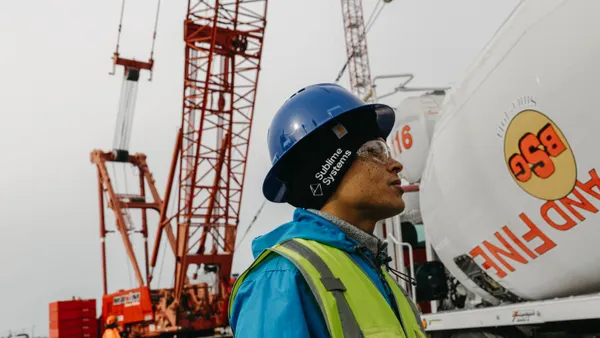Dive Brief:
- Gathering and applying detailed data analytics to improve safety on the jobsite may be easier than it appears, according to experts who gathered to discuss falls in construction during a May 7 webinar moderated by Construction Dive Editor Zach Phillips.
- The panel, hosted by OSHA during Construction Safety Week, featured experts from the safety agency, St. Louis-based builder Clayco and CPWR — The Center for Construction Research and Training. Together, they shared safety tips and resources that can help contractors keep their workers safe from falls.
- Suggestions from the panelists included tips for getting started with safety data collection and practical examples of how those statistics can inform experimentation and implementation of new safety practices, such as Clayco’s “Ladders Last” program, which encourages lifts or scaffolding use instead.
Dive Insight:
Falls, slips and trips accounted for 421, or nearly 40%, of all construction workplace fatalities in 2023, according to the U.S. Bureau of Labor Statistics most recent data. That was the highest share of any single hazard, so it’s no wonder jobsites across the country hosted stand downs May 7 to review fall safety.
Todd Friis, senior vice president of risk management at Clayco, said during the panel that the company has an in-house safety analyst who collects and reviews a wide variety of safety data in order to make decisions to improve workplace safety.
With that information, the company discovered that 10% of slip, trip and fall-related events involved ladders, along with several close calls where ladder use was a contributing factor. As a result, Clayco created its “Ladders Last” initiative that Friis said highly encouraged safer alternatives — such as lifts or scaffolding — and in some cases, required a permit for the tools’ use.
“We use data every week, and more often as needed, to really evaluate where we're at, and kind of keep a pulse on what's happening within the company,” Friis told viewers.
Jessica Bunting, director of research to practice at Silver Spring, Maryland-based CPWR, said that the best way to start using data is simply to begin gathering it, even if it needs to be done anonymously at first. However, Bunting also cautioned viewers not to use the data in a punitive way — chastising workers for what they get wrong — but instead, to focus on making the jobsite safer and reinforcing best practices.
Data dashboards
For smaller contractors who may be limited in the data they can collect, Bunting mentioned CPWR’s data center, which provides different reports and interactive data dashboards related to fall injuries and fatalities, along with other safety and health trends.
“I think it's really not that hard to start, and then it really can help you figure out where you want to spend your money, especially as a small contractor with limited resources,” Bunting said.
Other contractors have also used data to sharpen their safety efforts. Tricia Thibodeaux, vice president of health, safety and environmental for Irving, Texas-based Fluor, told Construction Dive the company was able to identify nine activities conducted widely across the company that present the greatest risk of a fatality or serious injury. It found these culprits by evaluating industry data and its own incident history.
“Fluor developed the Safer Choices Together program to educate workers about their personal risk tolerance and its impact on decision-making,” Thibodeaux told Construction Dive. “This initiative underscores the importance of making safer choices and recognizing potential hazards before they become issues.”














